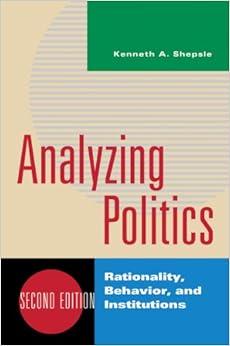
Free Downloads Analyzing Politics: Rationality, Behavior And Instititutions, 2nd Edition (New Institutionalism In American Politics)

Analyzing Politics makes the fundamentals of rational-choice theory accessible to undergraduates in clear, nontechnical language. Through case studies, illustrations, and examples, the author provides students with the means to analyze a wide variety of situations. The Second Edition has been thoroughly revised to include updated cases and examples, new problem sets and discussion questions, and new “Experimental Corner” sections at the end of many chapters, describing experiments from social science literature.

Paperback: 450 pages
Publisher: W. W. Norton & Company; 2 edition (June 16, 2010)
Language: English
ISBN-10: 0393935078
ISBN-13: 978-0393935073
Product Dimensions: 5.5 x 1.4 x 8.3 inches
Shipping Weight: 1 pounds (View shipping rates and policies)
Average Customer Review: 4.3 out of 5 stars See all reviews (6 customer reviews)
Best Sellers Rank: #48,978 in Books (See Top 100 in Books) #61 in Books > Politics & Social Sciences > Politics & Government > Elections & Political Process > General #62 in Books > Textbooks > Social Sciences > Political Science > Political History #83 in Books > Politics & Social Sciences > Politics & Government > Elections & Political Process > Elections

This book is required for one of my required upper division class. I am not a Poly Science major added to that I am foreign and I can understand th book pretty good. So I guess this book is explained really well.
Great book for beginners in learning about political science. The reading is not difficult and the examples illustrate the points very well. The author definitely kept in mind that the readers of the book would be students starting out in learning about political sciences.
To keep it simple: the author Kenneth Shepsle has a knack for explaining things. I'm surmising that the text was published for didactic purposes and is probably required (as it was for me) for many political science courses. The job was well done; the illustrations and examples nicely built on the subject at hand. There are four parts. The first is the introduction. The second is called Group Choice, and it does an excellent job in explaining the collective behavior of people when it comes to making choices such as elections.Voting methods are explained extremely well and so are the spacial models. The third part is called Cooperation, Collective Action, And Public Goods. In this section, rational behavior - cooperation, and game theory were discussed. I've read game theory for evolution in Richard Dawkin's The Selfish Gene, but here you'll read it from a political perspective and it does not disappoint. Part 4, called Institutions, is more political and talks about legislatures, courts and judges, cabinets, etc. The author portrays a higher level of sophistication in his writing, and nicely translates that to the reader. This is an excellent book if you want to understand political science.
Great for learning about individual and group rationale with basic statistical formulas. Not at all daunting, easy to read and learn- great segue-way.
it is really a good book to introduce the fundmental knowledge about political economic and pulic choice. I use it as my textbook.
Got it for a class and am deeply regretful for needing to do so... COME ON PEOPLE MOVE TO DIGITAL!! At least for school books...
Analyzing Politics: Rationality, Behavior and Instititutions, 2nd Edition (New Institutionalism in American Politics) CLEP Analyzing & Interpreting Literature with CD-ROM (REA): The Best Test Prep for the CLEP Analyzing and Interpreting Literature Exam with REA's TESTware (Test Preps) Rationality in Action (Jean Nicod Lectures) Analyzing American Democracy: Politics and Political Science Crucial Accountability: Tools for Resolving Violated Expectations, Broken Commitments, and Bad Behavior, Second Edition: Tools for Resolving Violated Expectations, ... and Bad Behavior, Second Edition AUDIO Construction Delays, Second Edition: Understanding Them Clearly, Analyzing Them Correctly Understanding Human Behavior: A Guide for Health Care Providers (Communication and Human Behavior for Health Science) Document Engineering: Analyzing and Designing Documents for Business Informatics and Web Services (MIT Press) Data Science and Big Data Analytics: Discovering, Analyzing, Visualizing and Presenting Data Labanotation: The System of Analyzing and Recording Movement Open Source Intelligence Techniques: Resources for Searching and Analyzing Online Information The Functional Approach to Data Management: Modeling, Analyzing and Integrating Heterogeneous Data SAP Performance Optimization Guide: Analyzing and Tuning SAP Systems, SAP Basis, SAP Administration CLEP Analyzing and Interpreting Literature 2017 Competitive Strategy: Techniques for Analyzing Industries and Competitors Programming Computer Vision with Python: Tools and algorithms for analyzing images Troubleshooting SNMP; Analyzing MIBs Analyzing Outsourcing CLEP® Analyzing & Interpreting Literature Book + Online (CLEP Test Preparation) Analyzing Short Stories



